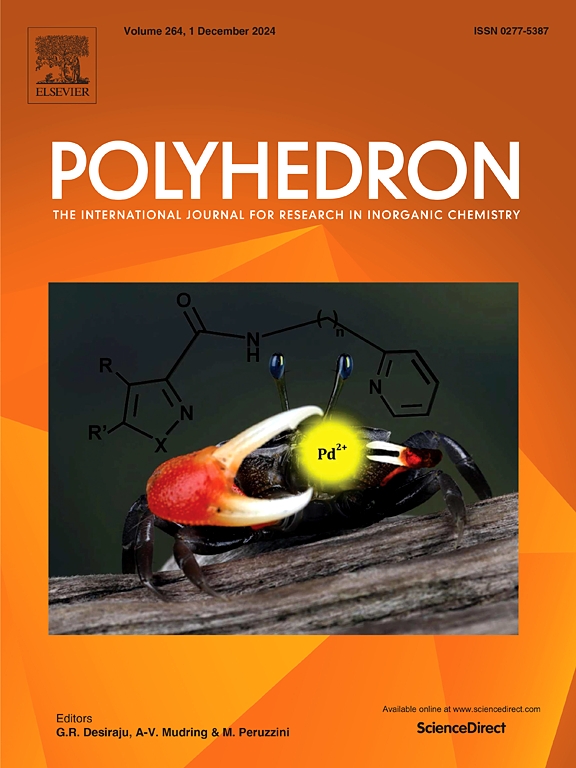杂双金属[feimnii]氰化物桥接配位聚合物的合成、表征及其体外抗肿瘤活性
IF 2.6
3区 化学
Q2 CHEMISTRY, INORGANIC & NUCLEAR
引用次数: 0
摘要
在六氟磷酸铵存在的DMF溶液中,顺式feii (bpy)2(CN)2·3H2O与MnII(OAc)·4H2O反应,得到了新型Fe-Mn氰化物桥接化合物1 {[fei2 (bpy)4(μ-CN)4MnII(DMF)2](PF6)2·H2O}n。通过红外光谱、电子吸收光谱、元素分析和x射线晶体学对化合物1进行了表征。化合物1在单斜晶系C2/c空间群中结晶。化合物1的晶体结构包含两个单核顺式feii (bpy)2(CN)2中性分子、一个[MnII(DMF)2]2+阳离子、两个不配位的PF6−阴离子和一个不配位的水分子。每个FeII(bpy)2(CN)2单元通过CN基团以顺式构象连接到两个[MnII(DMF)2]2+阳离子,每个[MnII(DMF)2]2+阳离子通过CN基团连接到四个FeII(bpy)2(CN)2单元。每两个FeII(bpy)2(CN)2单元通过氰基桥连接两个Mn2+离子,在顺式位置交替连接,形成一个12元环分子方阵。每个锰上剩下的两个顺式位置继续由另一个铁单元的两个氰基交替连接,这样的交替形成了一个二维结构。化合物1在A549、HeLa和MCF7细胞系中进行体外活性评价。本文章由计算机程序翻译,如有差异,请以英文原文为准。
![Synthesis and characterization of a heterobimetallic [FeIIMnII] cyanide-bridged coordination polymer and its in vitro antitumor activity](https://img.booksci.cn/booksciimg/2025-5/102303850171778529601.jpg)
Synthesis and characterization of a heterobimetallic [FeIIMnII] cyanide-bridged coordination polymer and its in vitro antitumor activity
A novel Fe-Mn cyanide-bridged compound 1, {[FeII2(bpy)4(μ-CN)4MnII(DMF)2](PF6)2·H2O}n, was achieved by reaction of cis-FeII(bpy)2(CN)2⋅3H2O with MnII(OAc)⋅4H2O in a DMF solution in the presence of ammonium hexafluorophosphate. Compound 1 was characterized by IR, electronic absorption spectra and elemental analysis, and X-ray Crystallography. Compound 1 crystallizes in the monoclinic system, space group C2/c. The crystal structure of compound 1 contains two mononuclear cis-FeII(bpy)2(CN)2 neutral molecule, one [MnII(DMF)2]2+ cation, two uncoordinated PF6− anions and one uncoordinated water molecule. Each FeII(bpy)2(CN)2 unit is connected to two [MnII(DMF)2]2+ cations via CN groups in cis-conformation, and each [MnII(DMF)2]2+ cation is linked to four FeII(bpy)2(CN)2 unit via CN groups. Each two FeII(bpy)2(CN)2 units bridge two Mn2+ ions through cyanido bridges in the cis- positions linked alternately to form a 12-membered ring molecular square. The two cis positions remaining on each manganese continue to be alternately connected by two cyanide groups from another iron unit, and such alternation forms a 2-dimensional structure. The in vitro activity of compound 1 was evaluated in A549 and HeLa as well as MCF7 cell lines.
求助全文
通过发布文献求助,成功后即可免费获取论文全文。
去求助
来源期刊

Polyhedron
化学-晶体学
CiteScore
4.90
自引率
7.70%
发文量
515
审稿时长
2 months
期刊介绍:
Polyhedron publishes original, fundamental, experimental and theoretical work of the highest quality in all the major areas of inorganic chemistry. This includes synthetic chemistry, coordination chemistry, organometallic chemistry, bioinorganic chemistry, and solid-state and materials chemistry.
Papers should be significant pieces of work, and all new compounds must be appropriately characterized. The inclusion of single-crystal X-ray structural data is strongly encouraged, but papers reporting only the X-ray structure determination of a single compound will usually not be considered. Papers on solid-state or materials chemistry will be expected to have a significant molecular chemistry component (such as the synthesis and characterization of the molecular precursors and/or a systematic study of the use of different precursors or reaction conditions) or demonstrate a cutting-edge application (for example inorganic materials for energy applications). Papers dealing only with stability constants are not considered.
 求助内容:
求助内容: 应助结果提醒方式:
应助结果提醒方式:


